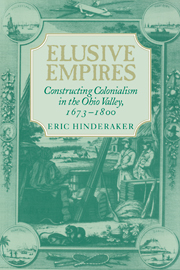Book contents
2 - Communities of Exchange
Published online by Cambridge University Press: 16 February 2010
Summary
As colonial commerce began to reshape the economic contours of the Ohio Valley, it also initiated wide-ranging changes in community life. For the Indian population that was already resident in the valley, trading opportunities often led them to relocate towns, take in European residents, and undertake sometimes dramatic cultural experiments in the interest of strengthening their ties with the colonies. For those who were moving into the valley, intercultural commerce structured new patterns of social and economic interaction and helped to erode the significance of tribal identity in determining patterns of residence and loyalty. In place of tribally defined political units, villages of mixed ethnicity operated with a substantial degree of independence from one another, even as colonial and Indian diplomats struggled to make old, tribally-based definitions of power and authority hold in the region. By the end of the colonial period, the Ohio Valley was characterized by widespread intercultural influence and contact, by far-reaching disruptions in the organizing patterns of Native American life, and by unprecedented innovations and experiments in social and cultural forms.
The reorientations of Native American life introduced by European contacts and trade in the Ohio Valley were fundamental enough to warrant an inquiry into the most basic elements of community. Everything from the siting and functions of villages and towns, to the dynamics of household and gender relations, to the structures of spiritual and political power that bound communities together were reshaped more or less directly in response to the European presence.
- Type
- Chapter
- Information
- Elusive EmpiresConstructing Colonialism in the Ohio Valley, 1673–1800, pp. 46 - 78Publisher: Cambridge University PressPrint publication year: 1997



